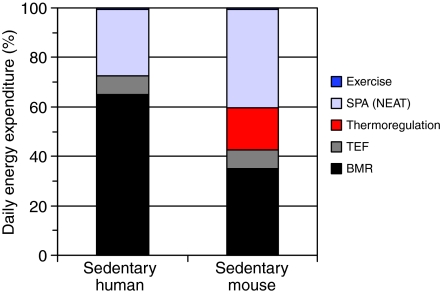Fig. 2.
(A,B) Partitioning of daily energy expenditure in a sedentary human and a sedentary laboratory mouse. The human engages in negligible voluntary exercise, and the mouse is housed without a wheel. At room temperature (∼21°C), people wear appropriate clothing and so do not have any extra energy expenditure to maintain body temperature. For mice, however, 21°C is below their thermoneutral zone, so they have a substantial cost of thermoregulation (e.g. see Hart, 1971; Hudson and Scott, 1979; Lacy and Lynch, 1979). The values depicted are approximations, based on the synthesis of a number of sources (e.g. http://www.fao.org/docrep/007/y5686e/y5686e04.htm) [Garland and others (Garland, 1983; Saris et al., 1989; Hammond and Diamond, 1997; Gorman et al., 1998; Girard, 2001; Swallow et al., 2001; Donahoo et al., 2004; Westerterp, 2004; Carbone et al., 2005; Vaanholt et al., 2007a; Vaanholt et al., 2007b; Johanssen and Ravussin, 2008; Rezende et al., 2009; Secor, 2009) and references therein]. BMR, basal metabolic rate; NEAT, non-exercise activity thermogenesis; SPA, spontaneous physical activity; TEF, thermic effect of food.

